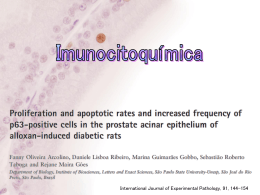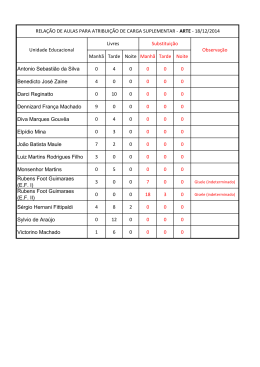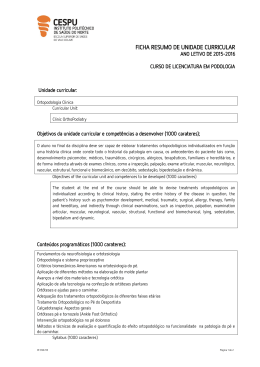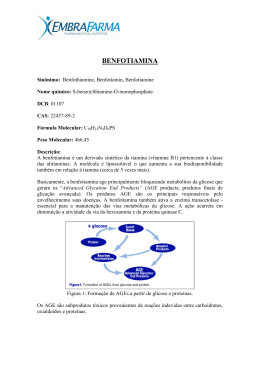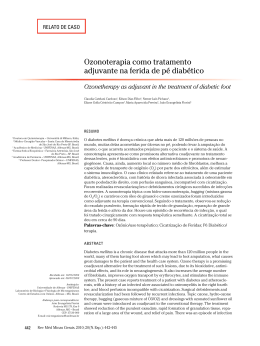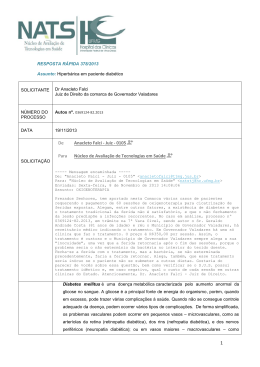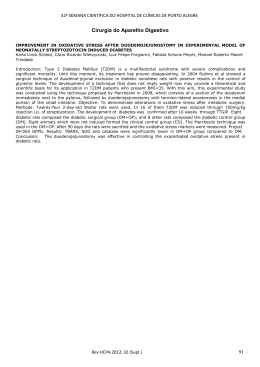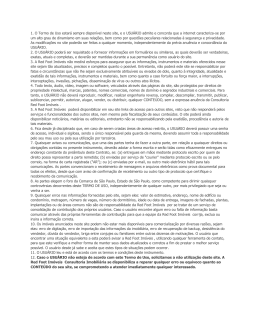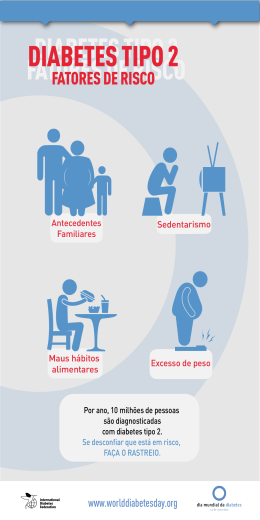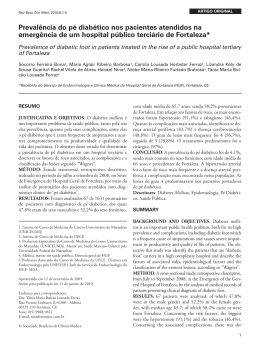artigo original Beatriz H. Jorge Maria de Fátima Borges Vinícius N. de Brito Thessa G.M. dos Santos Ana Cláudia P. Thirone Disciplina de Endocrinologia, Departamento de Clínica Médica Faculdade federal de Medicina do Triângulo Mineiro, Uberaba, MG. Análise Clínica e Evolução de 70 Casos de Lesões Podais Infectadas em Pacientes Diabéticos RESUMO O presente trabalho tem como objetivo analisar 70 pacientes diabéticos portadores de lesões podais infectadas, internados para tratamento no Hospital Escola da Faculdade Federal de Medicina do Triângulo Mineiro no período compreendido entre 1989 e 1998. As lesões foram analisadas considerando-se o tipo de diabetes mellitus (DM) apresentado pelo paciente, tempo decorrido entre o diagnóstico de DM e a internação, agentes etiológicos mais freqüentemente encontrados nas culturas das secreções, tipo de tratamento requerido e evolução clínica dos pacientes. A maioria dos pacientes estudados (87%) era portadora de DM tipo 2. Não se observou diferença estatística quanto ao sexo, com predomínio nas 6a e 7a décadas de vida. As lesões foram mais freqüentes nos pacientes com mais de 5 anos de diagnóstico de DM. As bactérias mais comumente encontradas nas culturas das secreções foram Proteus mirabilis e Staphylococcus sp. Os pacientes receberam terapia antibiótica específica, curativos diários e desbridamentos, quando necessários. Sessenta e um por cento dos pacientes requererem amputação e 15,7% foram a óbito por septicemia. As internações foram prolongadas, com duração média de 38 dias. As lesões podais em pacientes diabéticos são um grande problema de saúde pública. O tratamento é prolongado, podendo trazer mudanças drásticas na qualidade de vida dos pacientes. A prevenção ainda é a melhor maneira de combatermos este problema. (Arq Bras Endocrinol Metab 1999;43/5: 366-372) Unitermos: Diabetes mellitus; Lesões Podais; "Pé diabético"; Amputação; Infecção. ABSTRACT Recebido em 31/08/98 Revisado em 29/09/99 Aceito em 01/10/99 The purpose of this study is to analyze 70 patients with diabetic foot ulcers admitted as in-patients for treatment in the Triângulo Mineiro School of Medicine, Uberaba, MG. The lesions were evaluated considering the patient's type of diabetes mellitus (DM), the period of time between the diagnosis of DM and the admission, bacterial pathogens commonly found in the culture materials, the type of treatment required and the clinical outcome of the patients. Eightyseven per cent of the patients had type 2 DM. There was no relation to gender and the patients were mainly in the 6th and 7th decades of life. The lesions were more frequent in patients with more than 5 years' duration of DM. The most common bacterial pathogens detected in the culture materials were Proteus mirabilis and Staphylococcus sp. The patients were treated with specific antibiotics, daily dressings and debridements whenever needed. Amputation and mortality rates were 61.4% and 15.7%, respectively. The average length of in-hospital stay was 38 days and the causes of death were mainly sepsis. The diabetic foot is a public health problem of significant magnitude. It requires a long-term therapy and may result in drastic changes in the patients' lifestyle. Prevention is still the best Group. The effect of intensive treatment of Diabetes on the development and progression of long-term complications in insulin-dependent Diabetes Mellitus. N Engl J Med 1993; 329:977-86. 23. Bernardes CHA, Penteado JG, Martins MFS, Rosa VA, Tinós MS. Pé diabético: análise de 105 casos. Arq Bras Endocrinol Metab 1993;37:139-42. 24. Isakov E, Budoragin N, Shenhav S, et al. Anatomic sites of foot lesions resulting in amputation among diabetics and non-diabetics. Am J Phys Med Rehabil 1995;74:130-3. 25. Larsson J, Agardh CD, Apelqvist J, Stenström A. Clinical characteristics in relation to final amputation level in diabetic patients with foot ulcers: a prospective study of healing below and above the ankle in 187 patients. Foot Ankle Int 1995;16:69-74. 26. West NJ. Systemic antimicrobial treatment of foot infections in diabetic patients. Am J Health Syst Pharm 1995;52:1199-207. 27. Lavery LA, van Houtum WH, Harkless LB. In-hospital mortality and disposition of diabetic amputees in the Netherlands. Diabet Med 1996;13:192-7. 28. Harris Ml, Klein R, Welborn TA, Knuiman MW. Onset of NIDDM occurs at least 4-7 years before clinical diagnosis. Diabetes Care 1992;15:815-9. 29. Louie TJ, Bartlett JG, Tally FP, Gorbach SL. Aerobic and anaerobic bacteria in diabetic foot ulcers. Ann Intern Med 1976;85:461-3. 30. Sapico FL, Witte JL, Canawati HN, Montgomerie JZ, Bessman AN. The infected foot of the diabetic patient: quantitative microbiology and analysis of clinical features. Rev Infect Dis 1984;6:S171-6 35. Sathe SR. Managing the diabetic foot in developing countries. IDF Bulletin 1993;38:16-8. 36. Larsson J, Apelqvist J, Agardh CD, Stenström A, Decreasing incidence of major amputation in diabetic patients: a consequence of a multidisciplinary foot care team approach? Diabet Med 1995;12:770-6. 37. Levin ME. Preventing amputation in the patient with diabetes. Diabetes Care 1995;18:1383-94. 38. Faglia E, Favales F, Aldeghi A, et al. Change in major amputation rate in a center dedicated to diabetic foot care during the 1980's: prognostic determinants for major amputation. J Diabetes Complications 1998; 12:96-102. 39. Mandelberg A, Sheinfeld W. Diabetic amputations, amputation of lower extremity in diabetics - analysis of 128 cases. Am J Surg 1946;71:70-6. 40. Ecker ML, Jacobs BS. Lower extremity amputation in diabetic patients. Diabetes 1970;19:189-95. 41. Kahn O, Wagner W, Bessman AN. Mortality of diabetic patients treated surgically for lower limb infection and/or gangrene. Diabetes 1974;23:287-92. 42. Deerochanawong C, Home PD, Alberti KGMM. A survey of lower limb amputation in diabetic patients. Diabet Med 1992;9:942-6. 43. Eneroth M, Persson BM. Amputation for occlusive arterial disease, a prospective multicentre study of 177 amputees. Int Orthop 1992;16:383-7. 44. Helfand AE, Hirt PR. Caring for the diabetic: assessing risk in the diabetic foot. N J Med 1994;91:256-8. 31. Wheat LJ, Allen SD, Henry M, et al. Diabetic foot infections. Bacteriologic analysis. Arch Intern Med 1986; 146:1935-40. 32. Tan JS, File Jr TM. Diagnosis and treatment of diabetic foot infections. Compr Ther 1988; 14:57-62. 33. Gibbons GW, Eliopoulos GM. Infection of the diabetic foot: medical and surgical management. In Kozak GP, Campbell DR, Frykberg RG, Habershaw GM, eds. Management of Diabetic Foot Problems. 2nd ed. Philadelphia: W.B. Saunders Company, 1995;121-9. 34. Grayson ML. Diabetic foot infections. Antimicrobial therapy. Infect Dis Clin North Am 1995;9:143-61. Endereço para correspondência: Beatriz H. Jorge Hospital Escola da Faculdade Federal de Medicina do Triângulo Mineiro Departamento de Clínica Médica - Disciplina de Endocrinologia Avenida Getúlio Guaritá, s/n 38025-440 Uberaba - MG Fax: (034) 333-8710
Download
